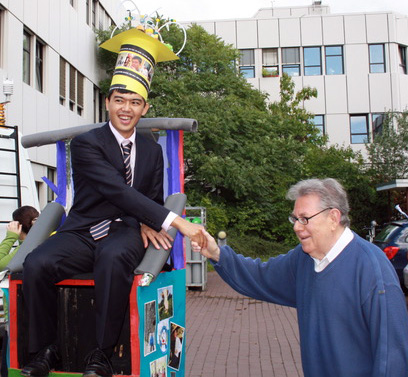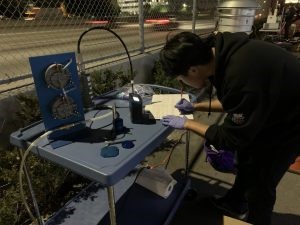Making A Difference — Manabu Shiraiwa
Manabu Shiraiwa was a highly recognizable figure in the world of air quality even before he joined UCI as an assistant professor of chemistry in 2016. As an associate professor of Chemistry, his interests have further expanded from global atmospheric studies to indoor air pollution… even to pollution generated from wearing our clothes too long!
The Shiraiwa group investigates the properties and multiphase processes of aerosol particles and their effects on atmospheric chemistry, air quality, and human health. Such studies are essential foraddressing societally relevant questions of air quality, global environmental change, and their impacts, including on public health.
Manabu has received several prestigious awards, among them the Kenneth T. Whitby Award, American Association for Aerosol Research (2020); the Paul J. Crutzen Award for Early Career Scientists, iCACGP (2018), and the Sheldon K. Friedlander Award, American Association for Aerosol Research (2014). The photo below shows Manabu with Paul Crutzen upon receiving his Ph.D.
In summer 2015, Manabu Shiraiwa attended a small workshop called “Interaction between Indoor and Atmospheric Chemistry” in Lille, France. The workshop had a strong impact on Manabu because he learned from indoor and building scientists about fascinating chemistry occurring in indoor environments; for example, ozone reacting with human skin to produce gaseous pollutants indoors. Right after the workshop, he decided to apply his kinetic multilayer modeling approach, which was originally developed for aerosol heterogeneous chemistry, to simulate heterogeneous chemistry occurring indoors.
 People in developed countries are estimated to spend 90% of their time indoors, which has become exaggerated during the COVID pandemic, as many people are in their homes nearly all day, every day. The World Health Organization estimates that 3.8 million people die prematurely from exposure to indoor air pollution per year. In comparison to outdoor air pollution, however, indoor air has been less studied. For a better assessment of the health impacts of air quality, Manabu seeks to more clearly understand what is going on in air passing through houses and buildings.
People in developed countries are estimated to spend 90% of their time indoors, which has become exaggerated during the COVID pandemic, as many people are in their homes nearly all day, every day. The World Health Organization estimates that 3.8 million people die prematurely from exposure to indoor air pollution per year. In comparison to outdoor air pollution, however, indoor air has been less studied. For a better assessment of the health impacts of air quality, Manabu seeks to more clearly understand what is going on in air passing through houses and buildings.
Since 2017, Manabu has been principal investigator on the Modelling Consortium for Chemistry of Indoor Environments (MOCCIE), a 6.5-year, $3 million initiative funded by the Alfred P. Sloan Foundation. MOCCIE is a unique effort to bring together modeling experts from a number of different fields to develop an integrated physical-chemical model that includes a realistic representation of gases, particles, and surfaces in indoor environments and how occupants, indoor activities, and building construction influence indoor processes. The multi-institutional team includes close collaboration with fellow AirUCI faculty Douglas Tobias (Chair of UCI’s Chemistry Department who conducts molecular dynamics simulations in his lab), as well as with several indoor chemists and building scientists from the U.S., U.K., and Canada.
The MOCCIE team has reported a number of findings with real-life implications. For a study published in Nature’s Communications Chemistry, they found that if one wears the same clothes every day and that clothing is soiled with skin oil, it means that upon ozone exposure you may generate potentially toxic gases with a cloud of pollutants surrounding you, also putting your peers at risk of exposure to pollutants.
Compared to the atmosphere outside, indoor environments have much higher surface-to-volume ratio, making chemistry occurring on indoor surfaces very prominent. Cooking can release particles containing organic and elemental carbon, which may deposit on indoor surfaces. People customarily clean work surfaces but seldom take the time to clean walls and ceilings, which could become sources of future emissions. One paper they published in PNAS showed that the fate of toxic compounds indoors can be controlled by the chemistry on indoor surfaces.
Ultimately, Manabu and his team hope that their research can inform the design and operation of buildings, such as ventilation and cleaning activities, leading to real benefits in better indoor air quality and public health. They also hope their work studying aerosol particles will lead to solutions for outdoor air quality and climate change. Details about Manabu’s group and research can be read on his research site.
One of their recent projects was to conduct particle sampling for two weeks at Southern California highway sites in collaboration with UC Riverside, AQMD, and the Desert Research Institute. PM2.5 was collected using a high volume sampler and size-segregated particles were collected using a cascade impactor. This photo shows Shiraiwa group grad student Brian Hwang working hard at 5 AM preparing to begin sampling freeway air near Long Beach. Brian won a poster award at AAAR’s 2020 meeting for this project.
Sampling and equipment setup were carried out in the wee hours of the morning and well into the evening. Particle analysis indicates that these particles contain substantial amounts of stable radicals and can cause generation of reactive oxygen species in the aqueous phase. These results imply that respiratory deposition of traffic particles may contribute to oxidative stress in human lungs.
Along with Doug Tobias, mentioned above, Manabu collaborates frequently with fellow AirUCI faculty, including Sergey Nizkorodov, Annmarie Carlton, Barbara Finlayson-Pitts, Jim Smith, Benny Gerber, and others. He is another excellent example of the AirUCI spirit of collaboration which lifts our whole group.

